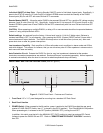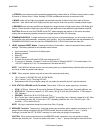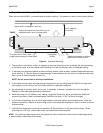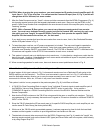
Model PA635 Page 11
© 2001 Xantech Corporation
CAUTION: After lead ends are inserted and the screws tightened down, be sure there are no free strands
that could cause shorting!
Speaker Phasing
To obtain stable imaging and full bass response, it is imperative that stereo speakers be connected "in phase"
with each other. You can verify this as follows:
a) If the "+" (positive) and "–" (negative) terminals on your speakers are correctly marked, and visible, and you
have wired the system as shown in Figs. 6 and 7, then the system will be "in phase". No further action is
required. Most manufacturers identify the positive terminal with a red binding post, a "+" sign, or a red dot.
b) If you are unsure of the markings, you can verify the phasing. Using a mono sound source, such as AM
radio, alternately reverse the leads to one of the speakers. Pick the connection that delivers a solid center
image between the speakers as well as best bass response.
Bridged Mode Connections
In general, it is recommended that the BRIDGED mode not be used in multi-room applications where
several speakers are driven through room volume controls and the like.
For such applications use the STEREO mode. Use the BRIDGED mode for single speaker, higher power
applications, such as in surround sound systems. Use speakers with an impedance rating of 8-Ohms minimum.
COMMON
LOCAL
CI
GROUND
STATUS
IR IN
STEREO
MONO
BRIDGED
MODE
LEFT RIGHT
SPEAKER
+-- --+
+ BRIDGED --
LEFT RIGHT
1
COMMON
LOCAL
CI
GROUND
STATUS
IR IN
STEREO
MONO
BRIDGED
MODE
LEFT RIGHT
SPEAKER
+-- --+
+ BRIDGED --
LEFT RIGHT
1
VIDEO
AUDIO
L
R
1
RCA Type
Patch Cords
Preamp Outputs
ZPR68, etc.
PA635
Rear Panel
+
Be sure speakers are
connected with correct
polarity as shown.
Wall speakers,
shelf speakers, etc.
Left Right
Set MODE
Switch to
BRIDGED position
+
Figure 7 – Bridged Mode Connections


















